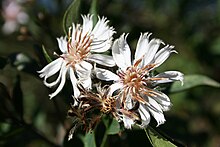Barnadesia
Appearance
| Barnadesia | |
|---|---|

| |
| Barnadesia sp. | |
| Scientific classification | |
| Kingdom: | |
| (unranked): | |
| (unranked): | |
| (unranked): | |
| Order: | |
| Family: | |
| Subfamily: | |
| Tribe: | |
| Genus: | Barnadesia |
| Synonyms[1] | |
| |
Barnadesia is a genus of flowering plants in the aster family, Asteraceae.[2][3] It is native to South America, where it is distributed from Colombia to northern Argentina, with most species occurring in the Andes.[4] Common names include clavelillo, chivo caspi, espino de gato, and espino santo.[4]
These plants are mainly shrubs and small trees,[5] the largest exceeding four meters in height.[6] The stems are spiny. The flower heads contain pink, red, or purple florets, including 8 to 13 hairy ray florets and usually either one or three disc florets. The ray floret yields a fruit with a plumelike pappus, and the fruit from a disc floret has a more "bristle-like contorted pappus".[5]
- Barnadesia aculeata
- Barnadesia arborea
- Barnadesia blakeana
- Barnadesia caryophylla
- Barnadesia ciliata
- Barnadesia corymbosa
- Barnadesia dombeyana
- Barnadesia glomerata
- Barnadesia horrida
- Barnadesia inermis
- Barnadesia jelskii
- Barnadesia kingii
- Barnadesia lehmannii
- Barnadesia macbridei
- Barnadesia macrocephala
- Barnadesia odorata
- Barnadesia parviflora
- Barnadesia polyacantha
- Barnadesia pycnophylla
- Barnadesia reticulata
- Barnadesia spinosa
- Barnadesia woodii
- Barnadesia wurdackii
References
Wikimedia Commons has media related to Barnadesia.
- ^ a b Flann, C (ed) 2009+ Global Compositae Checklist
- ^ Linnaeus, Carl von, Jr. 1782. Supplementum Plantarum 55, 348 in Latin
- ^ Tropicos, Barnadesia Mutis ex L. f.
- ^ a b Template:Es icon Barnadesia. Arboles y arbustos de los Andes del Ecuador. eFloras.
- ^ a b Hind, D. J. N. (2001). A new species of Barnadesia (Compositae: Barnadesieae) from Bolivia. Kew Bull 56(3), 705-10.
- ^ Hind, N. and T. Hall. (2003). Plate 459. Barnadesia arborea Compositae. Curtis's Botanical Magazine 20(1), 25-30.
- ^ Barnadesia species records. Bolivia Checklist. eFloras.
- ^ Urtubey, E. (1999). Revisión del género Barnadesia (Asteraceae: Barnadesioideae, Barnadesieae). Ann. Missouri Bot. Gard 86(1), 57-117.
External links
- Barnadesia. Preliminary Checklist of the Compositae of Bolivia. Royal Botanic Gardens, Kew.
- Miquel Bernades i Mainader | Galeria de Metges Catalans In Catalan
